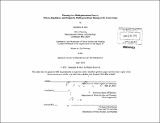| dc.contributor.advisor | James M. Buckley. | en_US |
| dc.contributor.author | Shin, Stephanie H | en_US |
| dc.contributor.other | Massachusetts Institute of Technology. Dept. of Urban Studies and Planning. | en_US |
| dc.coverage.spatial | n-us--- | en_US |
| dc.date.accessioned | 2012-10-10T15:49:02Z | |
| dc.date.available | 2012-10-10T15:49:02Z | |
| dc.date.copyright | 2012 | en_US |
| dc.date.issued | 2012 | en_US |
| dc.identifier.uri | http://hdl.handle.net/1721.1/73825 | |
| dc.description | Thesis (M.C.P.)--Massachusetts Institute of Technology, Dept. of Urban Studies and Planning, 2012. | en_US |
| dc.description | Cataloged from PDF version of thesis. | en_US |
| dc.description | Includes bibliographical references (p. 70-74). | en_US |
| dc.description.abstract | Multi-generational housing is a rising trend that is increasingly being considered as a viable housing option for the Boomerang generation, Baby Boomers and the aging population, and immigrant families. Cultural preferences, socio-economic factors, and the increasing availability of kin all contribute to people's decisions to live in multi-generational housing arrangements. However, the current housing landscape is inundated with suburban, single-family homes and a nuclear-family centered homebuilding industry and dominant culture in the United States does not match multi-generational housing needs. This thesis examines how planning professionals and practitioners may encourage more multi-generational housing opportunities as a way to age in place, live more efficiently in terms of space and finances, and meet demand that is largely being overlooked by developers and the existing housing opportunities of today. After a brief history of multi-generational housing in a U.S. context and the factors that contributed to both its decline post- World War 11 and its more recent resurgence, several different typologies are documented through interviews and case studies. The thesis ends with an examination of the largest barriers to the creation of more multi-generational housing, such as zoning and the disincentive to take on the risk of non-traditional development, and proposes recommendations to planners on how to overcome these challenges with planning interventions. The conclusion proposes and outlines the steps that can be taken following the completion of this thesis, including the creation of a practical guide or manual for planners on multi-generational housing that can be distributed to planners, organizations focused on the aging population, groups working to promote intergenerational activities and interaction, and other interested parties as a resource and how-to guide. | en_US |
| dc.description.statementofresponsibility | by Stephanie H. Shin. | en_US |
| dc.format.extent | 74 p. | en_US |
| dc.language.iso | eng | en_US |
| dc.publisher | Massachusetts Institute of Technology | en_US |
| dc.rights | M.I.T. theses are protected by
copyright. They may be viewed from this source for any purpose, but
reproduction or distribution in any format is prohibited without written
permission. See provided URL for inquiries about permission. | en_US |
| dc.rights.uri | http://dspace.mit.edu/handle/1721.1/7582 | en_US |
| dc.subject | Urban Studies and Planning. | en_US |
| dc.title | Planning for a multi-generational future : policies, regulations, and designs for multi-generational housing in the United States | en_US |
| dc.title.alternative | Policies, regulations, and designs for multi-generational housing in the United States | en_US |
| dc.type | Thesis | en_US |
| dc.description.degree | M.C.P. | en_US |
| dc.contributor.department | Massachusetts Institute of Technology. Department of Urban Studies and Planning | |
| dc.identifier.oclc | 811398410 | en_US |
